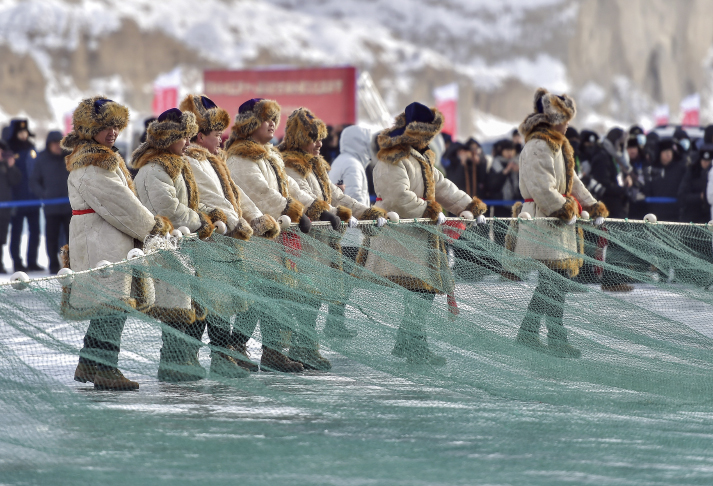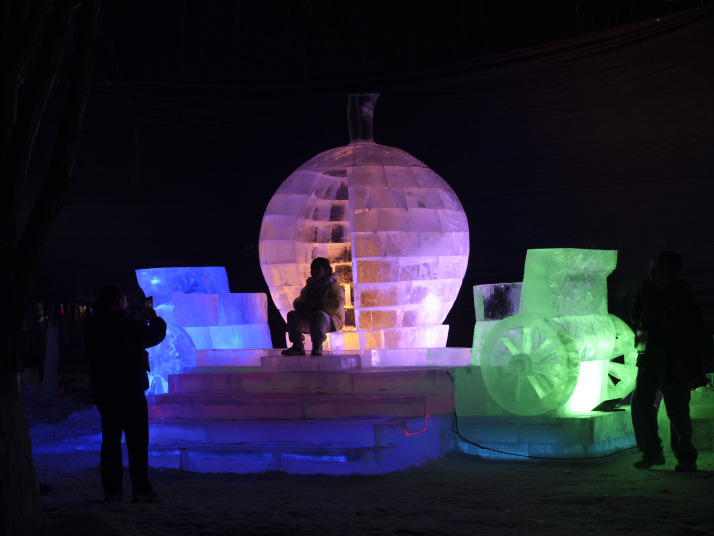| Xinjiang Today |
| From white to gold | |
|
|
 A traditional winter fishing ceremony takes place on the frozen Wulungu Lake in Altay Prefecture on January 18 (VCG)
Recently, China issued guidelines aimed at stimulating the ice and snow economy through the high-quality development of ice and snow sports. Building on the success of China's initiative to engage 300 million people in winter sports, the guidelines seek to leverage winter sports to promote ice and snow culture, equipment manufacturing and tourism, and to make this sector a new growth driver. (Engaging 300 million people in winter sports was an ambitious goal set by China in 2014. By April 2024, following the Beijing 2022 Winter Olympics, around 313 million people—over 22 percent of China's population—had participated in ice and snow activities—Ed.) The guidelines designated Xinjiang Uygur Autonomous Region, Inner Mongolia Autonomous Region, as well as Liaoning, Jilin and Heilongjiang provinces, all located in China's north, as core areas for developing "ice and snow economy pioneering zones of international renown." As the nation places greater emphasis on the ice and snow economy, Xinjiang's unique advantages have become increasingly prominent. Located on the "golden snow line" at 47 degrees North latitude, Xinjiang has abundant snowfall, a long snow season, extensive snowy areas and thick ice layers, making it a world-class destination for winter sports and tourism. Xinjiang should seize this opportunity to transform ice and snow into a powerful engine for high-quality development. The guidelines set ambitious targets: The total scale of China's ice and snow economy is expected to reach 1.2 trillion yuan ($164 billion) by 2027, and 1.5 trillion yuan ($205 billion) by 2030. These goals give Xinjiang momentum to unleash its potential.  An ice sculpture exhibition in Yining City, Ili Kazak Autonomous Prefecture, on January 19 (VCG)
Upward momentum In recent years, the development of Xinjiang's ice and snow economy has gained traction. Its ice and snow resources are being gradually converted into economic benefits. Xinjiang leverages the rich resources in its Altay and Tianshan mountain regions to boost the development of ice and snow industry clusters. High-quality projects like the Silk Road International Ski Resort, the Jiangjun Mountain International Ski Resort, and the Keketuohai International Ski Resort have attracted numerous domestic and international tourists. The consumption potential of winter tourism is being released. With the ongoing push to engage more people in winter sports, offerings in Xinjiang have expanded from simple skiing experiences to a diverse range of products, including cultural festivals, ice sculpture art exhibitions, and folk winter sports events, with both visitor numbers and total consumption increasing year by year. Ice and snow events are driving industrial upgrades. By hosting brand activities such as the Silk Road Ice and Snow Festival and the Wulungu Lake Winter Fishing Cultural Tourism Festival, as well as national-level comprehensive winter sporting competitions, Xinjiang is deeply integrating ice and snow sports with tourism. This not only enhances people's awareness and appreciation of Xinjiang as a desirable place to go, but also promotes the extension and development of related industry chains. Xinjiang's ice and snow infrastructure has been improving. Xinjiang is continuously increasing investment in infrastructure, promoting the modernization and multifunctional development of ski venues, and enhancing supporting facilities for ice and snow sports. Improved transportation conditions, especially the extension of high-speed rail, highways and flight routes, make it easier for more ice and snow enthusiasts to visit destinations in Xinjiang. Room for improvement Despite the notable achievements in the development of Xinjiang's ice and snow economy, challenges remain. To promote higher quality, deeper and more effective development, Xinjiang should focus its attention on the following areas: First, optimizing the regional layout and creating pioneering zones. It is essential to optimize the regional layout based on the unique resource endowments of different areas in Xinjiang. While focus is put on regions such as Altay, Ili and Urumqi in the north, efforts will also be made to encourage the development of the ice and snow economy in the south according to local conditions. Ice and snow-themed tourism clusters should be created, and diversified products and services like skiing, hot spring baths and folk customs experiencing will be provided. Second, promoting the collaborative development of the industrial chain. It is vital to enhance the entire industrial chain surrounding ice and snow sports and tourism. Special emphasis should be placed on strengthening the research and production of equipment, accelerating breakthroughs in key technologies such as ski lifts, and establishing an equipment industrial park to attract domestic and international investment. At the same time, it is essential to continue to more deeply integrate ice and snow culture with the tourism industry. This can be achieved by launching more artistic and festive activities themed around ice and snow, which will enhance the cultural soft power of the region and inject greater cultural value into the industrial chain. Third, enhancing the quality of services. It is crucial to innovate and diversify the ice and snow consumption experience by introducing products such as combo tickets and ski vacation packages to encourage public participation. It is important to optimize the payment and service environment, strengthen the protection of tourist rights, and provide a more convenient and safer experience. Increasing access to sports venues is essential, along with improving infrastructure and public services. Strengthening transportation links between cities and attractions, especially by creating convenience for transporting ice and snow equipment via rail and air, will enhance overall service quality. Continuous improvement in management capabilities and service quality is necessary to attract more people to participate in winter sports tourism in Xinjiang. Fourth, strengthening talent development and technological support. Programs related to the ice and snow economy should be established in universities and vocational schools in Xinjiang. Encouraging retired athletes to participate in training and enhancing the development of coaches and referees will gradually address the shortage of professional talent in this field. Promoting the digital and intelligent transformation of the industry by leveraging big data and artificial intelligence will optimize the operation of venues, improving service efficiency and experience quality. Fifth, deepening international cooperation and expanding openness. The establishment of the China-Shanghai Cooperation Organization winter sports demonstration zone presents an opportunity to foster related exchange with Belt and Road Initiative partner countries. (The Belt and Road Initiative is a China-proposed initiative that aims to boost connectivity along and beyond the ancient Silk Road routes—Ed.) Cross-border events and tourism projects will attract international visitors to enjoy ice and snow in Xinjiang. Participation in the formulation of international standards and technical cooperation will enhance the global reputation of Xinjiang's ice and snow industry. As a core area of the Belt and Road Initiative, Xinjiang can host international sport events and tourism festivals to draw tourists from Belt and Road nations to experience its culture and unique ethnic customs. Additionally, collaboration with international ice and snow sports organizations will further expand the export of related products and help nurture globally competitive brands. Sixth, strengthening policy support and financial backing. Financial institutions should be encouraged to innovate products related to the ice and snow industry and to increase credit support, which will help businesses overcome financing challenges. Measures such as loan interest subsidies have the potential to reduce operational costs for enterprises, providing essential financial support for the high-quality development of the ice and snow economy. Moreover, prioritizing projects in this sector when allocating new construction land will revitalize underutilized land while supporting its continuous expansion and upgrading. Han Tao is a lecturer at Kashi University's School of Physical Education and Liu Feng is a professor at the Physical Education and Research Department ofXinjiang University Comments to yanwei@cicgamericas.com |
|
||||||||||||||||||||||||||||||
|